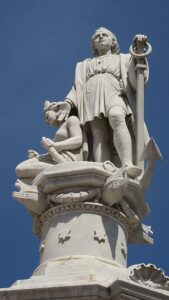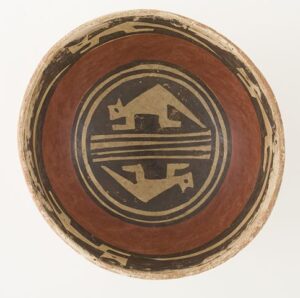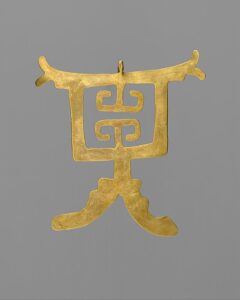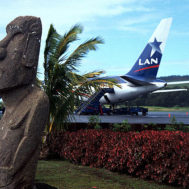The Global Heritage Alliance (“GHA”) and the Committee for Cultural Policy (“CCP”)[1] are pleased to comment on a proposed renewal of a Memorandum of Understanding (“MOU”) with Colombia.

Christopher Columbus statue, depicted dominating an indigenous person. Centro Historico of Cartagena, Colombia. Photo by Joe Ross from Lansing, Michigan, 19 January 2016. Wikimedia Commons, Creative Commons Attribution-Share Alike 2.0 Generic license.
GHA and CCP believe that recent events, which have seen academics associated with the Archaeological Institute of America (“AIA”), the Antiquities Coalition, and ATHAR project, seek to justify, or even incite mob violence to tear down statues of Columbus[2], St. Junípero Serra, the Hispanic founder of California missions, and others, exposes the fundamental truth that their advocacy is not really about “conservation,” but rather “control.[3]” Under the circumstances, GHA and CCP submit that a new paradigm, one that facilitates lawful trade, and holds archaeologists and State Parties accountable for preservation efforts, should be adopted.
Here, if a renewal is recommended, any such a MOU should be conditioned on limiting the designated list and holding Colombia accountable to reasonable benchmarks that address congressionally mandated self-help measures. Moreover, any restrictions must be prospective, limiting detention, seizure and forfeiture to items illicitly exported from Colombia after the effective date of any governing regulations. Under no circumstances should restrictions be applied to items that are neither archaeological nor ethnological in character.
A. U.S. Law
The Cultural Property Implementation Act (“CPIA”), 19 U.S.C. §§ 2601 et seq. contains significant procedural and substantive constraints on the executive authority to impose import restrictions on archaeological and ethnological objects. The Cultural Property Advisory Committee (“CPAC”) is to provide the executive with useful advice about this process. Id. § 2605. “Regular” restrictions may only be applied to archaeological artifacts of “cultural significance” “first discovered within” and “subject to the export control” of a specific UNESCO State Party. 19 U.S.C § 2601. There must be some finding that the cultural patrimony of the UNESCO State Party is in jeopardy. Id. § 2602. They must be part of a “concerted international response” “of similar restrictions” of other market nations, and can only be applied after less onerous “self-help” measures are tried. Id. They must also be consistent with the general interest of the international community in the interchange of cultural property among nations for scientific, cultural, and educational purposes. Id.

Museo de Artillería de Cartagena-Despacho Sr. Coronel, photo by Yaco Erisso, 20 July 2015,
Creative Commons Attribution-Share Alike 4.0 International license.
Leaving aside limitations on entering into agreements, there are also strict limitations on what types of artifacts may be restricted. In particular, import restrictions may only be applied to archaeological and ethnological artifacts of “cultural significance” “first discovered within” and “subject to the export control” of a specific UNESCO State Party. Id. § 2601 (2). They must be part of a “concerted international response” of other market nations, and can only be applied after less onerous “self-help” measures are tried. Id. § 2602 (a) (1). They must also be consistent with the general interest of the international community in the interchange of cultural property among nations for scientific, cultural, and educational purposes. Id.
The definitions of archaeological and ethnological objects limit the scope of any restrictions. Section 2601 defines them as follows:
(2) The term ―archaeological or ethnological material of the State Party means –
(A) any object of archaeological interest;
(B) any object of ethnological interest; or
(C) any fragment or part of any object referred to in subparagraph (A) or (B); which was first discovered within, and is subject to export control by, the State Party. For purposes of this paragraph—
(i) no object may be considered to be an object of archaeological interest unless such object –
(I) is of cultural significance;
(II) is at least two hundred and fifty years old;
and (III) was normally discovered as a result of scientific excavation, clandestine or accidental digging, or exploration on land or underwater; and
(ii) no object may be considered to be an object of ethnological interest unless such object is –
(I) the product of a tribal or nonindustrial society, and
(II) important to the cultural heritage of a people because of its distinctive characteristics, comparative rarity, or its contribution to the knowledge of the origins, development, or history of that people.
The legislative history underscores the fact that “ethnological material” is to be defined narrowly. According to the Senate Report, Ethnological material
“includes any object that is the product of a tribal or similar society, and is important to the cultural heritage of a people because of its distinctive characteristics, its comparative rarity, or its contribution to the knowledge of their origins, development or history. While these materials do not lend themselves to arbitrary age thresholds, the committee intends this definition, to encompass only what is sometimes termed “primitive” or “tribal” art, such as masks, idols, or totem poles, produced by tribal societies in Africa and South America. Such objects must be important to a cultural heritage by possessing characteristics which distinguish them from other objects in the same category providing particular insights into the origins and history of a people. The committee does not intend the definition of ethnological materials under this title to apply to trinkets and other objects that are common or repetitive or essentially alike in material design, color, or other outstanding characteristics with other objects of the same type, or which have relatively little value for understanding the origins or history of a particular people or society.”
U.S. SENATE REPORT, 97-564 at 5 (emphasis added)
B. GHA and CCP Concerns about the Colombian Request
- No Showing of Current Looting
CPIA import restrictions are meant to address current looting not looting that took place decades ago when mores and laws were different. Here, to date the State Department has not produced evidence of current looting showing that Colombia’s cultural patrimony is currently in danger. Under the circumstances, CPAC should question Colombian authorities closely before CPAC can make the required finding that Colombia’s cultural patrimony is in danger.
- Any MOU Should Be Conditioned on Benchmarks for Self-Help Measures.

Resist-painted ceramic, Colombia, Colombia, Nariño, Tuza, 1000-1500, Muñoz Kramer Collection, Los Angeles County Museum of Art, Public Domain.
Before any MOU with Colombia may be agreed to, CPAC must advise whether “Colombia has taken measures consistent with the Convention to protect its cultural patrimony.” Id. § 2602 (A) (1) (B). The CPIA further requires a finding that “remedies less drastic than the application of the restrictions . . . are not available.” Id. § 2602 (A) (1) (C) (ii).
The U.S. House of Representatives Committee on Appropriations[4] recently reemphasized the need for CPAC to assess self-help measures as part of the MOU renewal process as follows:
Cultural Property.–The Cultural Properties Implementation Act (CPIA) requires countries participating in MOUs restricting cultural property take significant self-help measures. The Committee urges the Cultural Property Advisory Committee to consider the annual national expenditures on securing and inventorying cultural sites and museums in its annual reviews of the effectiveness of MOUs, as well as during the reviews required by the CPIA for extension of an MOU. The Committee also requests the Secretary of State review the feasibility of collecting and reporting on the cost of measures taken by partner countries in support of their cultural property MOU with the United States and be prepared to report on such review during the hearing process on the fiscal year 2019 budget request.
House Report 115-253 at 11.
The current MOU with Colombia already contemplates that Colombia will undertake site preservation and conservation measures as well as law enforcement measures as conditions for any renewal. MOU Art. II, C-E, H-K. Here, it is unclear what steps Colombia has taken with regard to these commitments, and CPAC will need to assess whether Colombia has complied with its promises during this renewal process.

Precolumbian pendant, gold, Capulí era, Colombian/Ecuadorian highlands, 4th–10th century AD, Metropolitan Museum of Art, Creative Commons CC0 1.0 Universal Public Domain Dedication.
In addition, GHA and CCP also suggest that CPAC recommend that Colombia investigate the creation of a portable antiquity reporting scheme for objects found on private land. Once objects reported under that scheme are registered, land owners and/or finders acting with the permission of the landowner should be allowed to retain or sell common objects not necessary for state museums. Such a program, which has been quite successful in the United Kingdom,[5] could be a model for countries such as Colombia, at least as far as common, redundant objects found on private land are concerned.
There are two other areas where self-help measures may address looting at archaeological sites. First, CPAC should recommend that U.S. archaeologists working in Colombia ensure there is year round site security at their sites. This can now be accomplished in a cost effective manner with the use of cameras and other low cost electronic security devices. Second, CPAC should recommend that U.S. archaeologists pay their archaeological workers a fair living wage. This will help provide a disincentive for the “subsistence digging.”
- CPAC Should Limit the Scope of Any Designated List.
The current designated list includes Colonial era ethnographic material in addition to pre-Columbian archaeological material. It is unclear at this juncture whether there will be any effort to expand this further; however, if so, care should be taken not to include coins in any expanded designated list. .
Colonial era coins were not only struck in Colombia, but at other mints located throughout the Spanish Empire as well. It is our understanding that Republican era coins were struck not only within Colombia, but within the U.K. as well. Spanish Colonial and Republican era coins are not archaeological in nature; they either do not meet the 250 year threshold and/or are not “normally discovered” within the ground. See 19 U.S.C. § 2601 (2) (C) (i) (II) (III). Nor do coins meet the definition of ethnological objects. Id. § 2601 (2) (C) (ii). They are not made individually, but by sophisticated industrial processes. Finally, due to their circulation in international commerce, one cannot assume such coins were “first discovered within” and hence were “subject to export control by” Colombian authorities. Id. § 2601 (2) (C). Indeed, early coins that circulated within Colombia were also legal tender in the United States until 1857.
Moreover, CPAC should take care that any import restrictions are only applied prospectively to items on the designated list illicitly exported from Colombia after the effective date of governing regulations. 19 U.S.C. § 2606. Unfortunately, CBP instead applies import restrictions far more broadly to any cultural goods imported into the United States after the effective date of import restrictions, i.e., an embargo, not targeted, prospective import restrictions.
C. Conclusion
If CPAC recommends an extension of the agreement with Colombia, any such a MOU should be conditioned on limiting the designated list and holding Colombia accountable to reasonable benchmarks that address congressionally mandated self-help measures. Under no circumstances should restrictions be applied to items that are neither archaeological nor ethnological in character.
Information on Meeting of the Cultural Property Advisory Committee at the Department of State, Bureau of Educational and Cultural Affairs
The Cultural Property Advisory Committee (CPAC) will hold an open session on renewal requests from Colombia and Italy on July 22, 2020, at 2:00 p.m. (EDT). It will last approximately one hour.
Participation: You may participate in the open session by video-conference. To participate, visit http://culturalheritage.state.gov for information on how to access the meeting. Please submit any request for reasonable accommodation not later than July 14, 2020, by contacting the Bureau of Educational and Cultural Affairs at [email protected]. It may not be possible to accommodate requests made after that date.
Comments: The Committee will review your written comment if it is received by July 8, 2020, at 11:59 p.m. (EDT). You are not required to submit a written comment in order to make an oral comment in the open session. The meeting will be held by videoconference.
Written Comments: You may submit written comments in two ways, depending on whether they contain privileged or confidential information:
Electronic Comments: For ordinary comments, please use http://www.regulations.gov, enter the docket [DOS–2020–0022] and follow the prompts to submit your comments.
Email Comments: For comments that contain privileged or confidential information (within the meaning of 19 U.S.C. 2605(i)(1)), please email submissions to [email protected]. Include ‘‘Italy’’ and/or ‘‘Colombia’’ in the subject line.
FOR FURTHER INFORMATION CONTACT: For general questions concerning the meeting, contact Allison Davis, Bureau of Educational and Cultural Affairs— Cultural Heritage Center, by phone (202–632–6307) or email (culprop@ state.gov).
Footnotes
[1]The Global Heritage Alliance, 5335 Wisconsin Ave., N.W., suite 440, Washington, D.C. 20015. http://global-heritage.org/ . The Committee for Cultural Policy, POB 4881, Santa Fe, NM 87502. www.culturalpropertynews.org, [email protected]. The Committee for Cultural Policy (CCP) is an educational and policy research organization that supports the preservation and public appreciation of the art of ancient and indigenous cultures. CCP supports policies that enable the lawful collection, exhibition, and global circulation of artworks and preserve artifacts and archaeological sites through funding for site protection. CCP deplores the destruction of archaeological sites and monuments and encourage policies enabling safe harbor in international museums for at-risk objects from countries in crisis. CCP defends uncensored academic research and urges funding for museum development around the world. CCP believes that communication through artistic exchange is beneficial for international understanding and that the protection and preservation of art is the responsibility and duty of all humankind. The Committee for Cultural Policy, POB 4881, Santa Fe, NM 87502. www.culturalpropertynews.org, [email protected].
Global Heritage Alliance (GHA) advocates for policies that will restore balance in U.S. government policy in order to foster appreciation of ancient and indigenous cultures and the preservation of their artifacts for the education and enjoyment of the American public. GHA supports policies that facilitate lawful trade in cultural artifacts and promotes responsible collecting and stewardship of archaeological and ethnological objects. The Global Heritage Alliance, 5335 Wisconsin Ave., NW Ste 440, Washington, DC 20015. http://global-heritage.org/
[2] The name “Colombia” is derived from the last name of the Italian navigator Christopher Columbus (Italian: Cristoforo Colombo, Spanish: Cristóbal Colón).
[3] See Professor of ‘Art Crime’ Instructs Protesters on Better Way to Topple Statues that Offend Them, The College Fix (June 11, 2020) (describing Prof. Erin Thompson’s advice to tear down a Columbus statue and Prof. Sarah Parcak’s advice to tear down a memorial obelisk to Confederate troops in Birmingham, Ala.), available at https://www.thecollegefix.com/professor-of-art-crime-instructs-protesters-on-better-way-to-topple-statues-that-offend-them/ (last visited June 26, 2020). Both Prof. Thompson and Prof. Parcak are associated with the Antiquities Coalition. See https://theantiquitiescoalition.org/?s=Thompson+ (last visited June 26, 2020); https://theantiquitiescoalition.org/?s=+Parcak (last visited June 26, 2020). Prof. Parcak also serves as an AIA trustee. See https://www.archaeological.org/about/governance/board/ (last visited June 26, 2020). Recently, Katie Paul of the ATHAR Project told Al-Monitor, “The statues toppled in the United States and Europe are symbolic representations that deify slave owners and genocidal leaders. They are being removed or vandalized today because they idolize figures who committed the worst kind of oppression,… The Pyramids were not constructed to idolize slavery or genocide nor do they serve as monuments to revere an era of oppression.” See Shahira Amin, Archaeologists, Activists Alarmed by Online Calls to Demolish Pyramids, Al-Monitor (June 17, 2020), available at https://www.al-monitor.com/pulse/originals/2020/06/blm-black-lives-matter-activists-pyramids-george-floyd.html#ixzz6QUbJ5omn (last visited June 26, 2020). Of course, despite Ms. Paul’s spin, the Pyramids were constructed by conscripted labor, and ancient Egypt’s ruling elite maintained large numbers of slaves, chiefly captured prisoners of war, who were used for forced labor, including monumental construction projects. Paul has also defended violent tear downs of statues to former President Grant and Fr. Serra. See https://twitter.com/AnthroPaulicy/status/1274348319913816064 (Grant, last visited June 26, 2020) and https://twitter.com/AnthroPaulicy/status/1274341913647341568 (Fr. Serra, last visited June 26, 2020). Grant’s contributions as a war winning Civil War General and anti KKK President are well known. For alternate views of Columbus and Fr. Serra statues, see John M. Viola, Tearing Down Statues of Columbus Also Tears Down My History, The New York Times (Oct. 9, 2017), available at
https://link.edgepilot.com/s/f0db2f9f/SjQ3TxG_FkqtUpUovQ0xBQ?u=https://www.nytimes.com/2017/10/09/opinion/christopher-columbus-day-statue.html (last visited June 26, 2020); Boycott Richmond, Primo Magazine, available at http://www.onlineprimo.com/ (last visited June 26, 2020); Paul Kengore, Taking Down St. Junípero Serra, National Catholic Register (June 25, 2020) available at https://www.ncregister.com/daily-news/taking-down-st.-junipero-serra (last visited June 26, 2020). GHA and CCP submit that any decision to remove a statue from public view must be handled peacefully, consistent with federal, state, and local law.
[4] In its recent submission in support of a MOU request from Costa Rica, the Archaeological Institute of America (“AIA”) cited a more recent Senate Report to contend this language was superseded. In so doing, the AIA showed a fundamental misunderstanding of the legislative process. Congressional reports are not treated the same way as subsequently passed legislation. Moreover, the language the AIA cited was not in any event inconsistent with the above House language.
[5] For more about the United Kingdom’s voluntary Portable Antiquity Scheme and mandatory Treasure Act, see https://finds.org.uk/ (last visited April 10, 2018).
 View of the Santa Cruz de Manga Islands, Boca Grande and Castillo Grande and Tierra Bomba seen from Cerro de la Popa photo by Norma Gòmez, Cartagena de Indias, Colombia. 1 February 2008, Creative Commons Attribution 2.0 Generic license.
View of the Santa Cruz de Manga Islands, Boca Grande and Castillo Grande and Tierra Bomba seen from Cerro de la Popa photo by Norma Gòmez, Cartagena de Indias, Colombia. 1 February 2008, Creative Commons Attribution 2.0 Generic license. 

